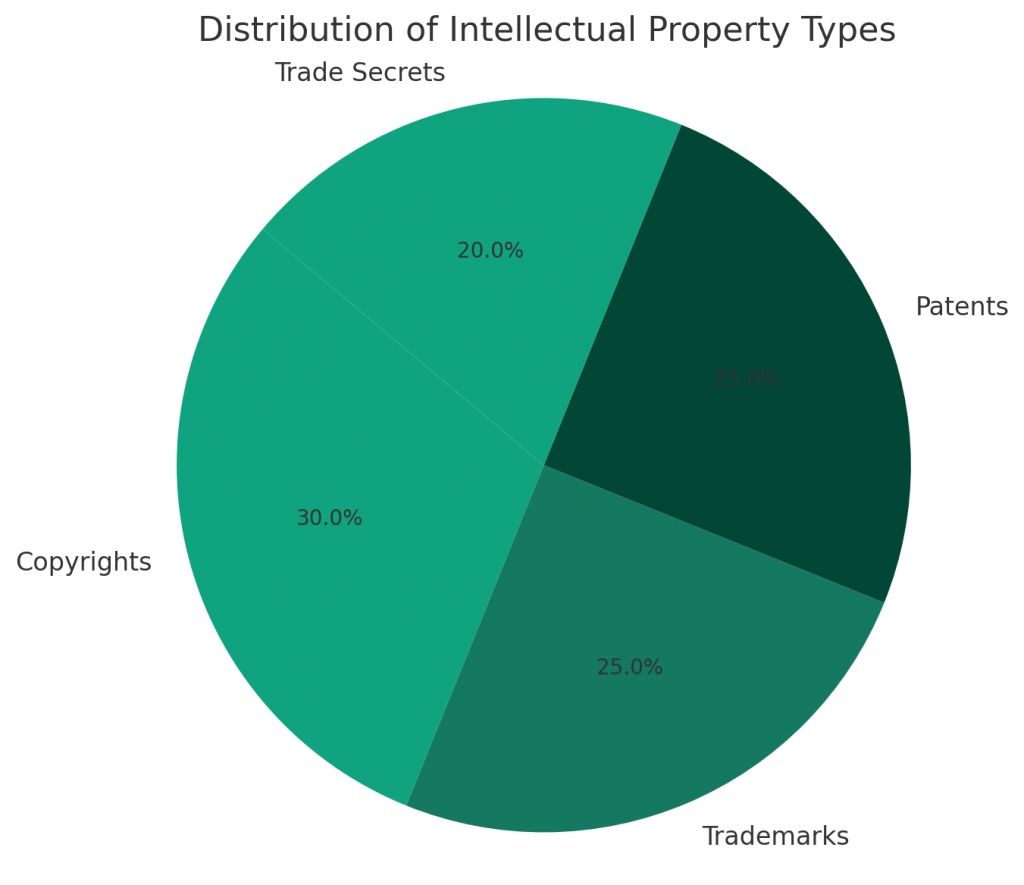Safeguarding Creative Assets: A Guide to Intellectual Property Protection
You’ve labored to bring your creation to life, but you wonder how to safeguard it from theft or misuse. The truth is your ideas, designs, and inventions – known as Intellectual Property (IP), hold immense value in today’s knowledge-driven marketplace.
This blog will provide you with a clear understanding of different types of IP like copyrights, trademarks, patents, and trade secrets and guide you on how to protect them effectively.
Get ready for an insightful journey into the world of intellectual property protection!
Key Takeaways
- Document your discoveries: Keep detailed records, date all documents, use a lab notebook, preserve prototypes or models, and utilize digital documentation.
- Use digital rights management systems: Protect your intellectual property online by using DRM systems to prevent unauthorized copying and distribution.
- Implement strong nondisclosure agreements: Ensure trade secret protection by establishing NDAs that restrict the sharing of sensitive information.
- Create strong access credentials: Reduce the risk of unauthorized access to your IP by implementing measures such as separating teams and regularly updating passwords.
- Register copyrights, trademarks, and patents: Enhance legal recognition and enforcement capabilities for your IP by registering these forms of intellectual property.
- Register business, product, or domain names: Establish ownership and protect the value of your brand by registering unique names.
Understanding Intellectual Property
Intellectual property includes copyrights, trademarks, utility patents, and trade secrets.
Copyrights
Copyrights can be a strong shield for your written and artistic works, including everything from novels and song lyrics to photographs and paintings. The protection they offer isn’t fleeting either; it lasts as long as the creator is alive, plus an additional 70 years beyond that.
This formidable line of defense makes it harder for others to directly copy what you’ve crafted, although copyrights don’t extend their cover over independently developed ideas with similarities.
While not obligatory, registering your copyright proves beneficial in fortifying your intellectual property. An online application typically costs $55: a small price to pay for comprehensive rights over your work.
Trademarks
Trademarks serve as identifying marks for goods or services. They often take the form of words, phrases, symbols, and logos. The primary purpose is to distinguish your products from others in the market.
A unique trademark makes your product easily recognizable to customers. Registering a trademark warrants certain exclusive rights and protection. Though not mandatory, it provides you with stronger power when defending against infringement cases. The process involves filling out a standard form and paying a fee of $275 per class.
Once registered, trademarks can last indefinitely if used in business and renewed every 10 years. It’s important to note that trademark rights go to the first party who uses it commercially.
Utility patents
Utility patents are a shield for your inventions. They offer 20 years of protection, ensuring no one else can produce or sell the same invention without your permission. Useful for safeguarding new processes, materials or technology advancements, they grant you exclusive economic advantage over your discovery.
The importance of registering utility patents with the U.S. Patent and Trademark Office (USPTO) cannot be overstated; it’s a required step within a year of public release to ensure intellectual property rights enforcement over potential patent infringers.
A utility patent is not just an incentive but also strengthens business assets – especially if production procedures involve novel techniques or designs protected by such patents.

Trade secrets
Companies often keep trade secrets under wraps to gain a competitive edge. This could include anything, from a unique manufacturing process to a cutting-edge chemical formula. Unlike other forms of intellectual property rights like patents or copyrights, these secrets have no formal protection.
However, if any theft occurs, the courts can enforce disciplinary actions. To protect these vital assets, organizations use several strategies. One effective method involves documenting all discoveries and innovations in detail. This record keeps clear evidence of original ideas and their authors.
Additionally, the utilization of digital rights management (DRM) systems helps safeguard online content while asserting ownership claim. Companies may also enter into nondisclosure agreements (NDAs) with employees and partners restricting dissemination of sensitive information that falls under trade secrets category thus preventing potential misappropriation.
How to Secure Your Intellectual Property
Protect your intellectual property by documenting your discoveries, using digital rights management systems, and registering copyrights, trademarks, and patents. Find out more on how to secure your intellectual property here.
Document your discoveries
To protect your intellectual property, it is important to document your discoveries. This can help establish a record of when the idea or invention was first developed, which can be crucial in case of any legal disputes or infringement claims. Here are some ways you can document your discoveries:
- Keep detailed records: Maintain clear and organized documentation of the entire research and development process. This includes notes, sketches, diagrams, and any other relevant information.
- Date all documents: Ensure that each document is dated and signed by the person involved in the discovery process. This helps establish a timeline of when the ideas were generated.
- Use a lab notebook: Keep a dedicated lab notebook where you can record all experiments, observations, results, and conclusions. This serves as an official record of your work.
- Preserve prototypes or models: If applicable, create physical prototypes or models of your invention and keep them safely stored as evidence of your creation.
- Use digital documentation: In addition to physical records, make use of digital tools to document your findings. This can include saving electronic files with timestamps and using cloud storage solutions for added security.
Use digital rights management (DRM) systems
DRM systems are a valuable tool for protecting your intellectual property online. They help prevent unauthorized copying, distribution, and use of copyrighted materials by establishing ownership and limiting access.
With DRM, creators can track and control how their intellectual property is used, providing evidence of ownership in legal disputes or enforcement actions. These systems are especially effective in safeguarding against piracy and unauthorized distribution of digital content.
Whether it’s written works, artistic creations, or software, DRM can provide the necessary protection to ensure that your intellectual property remains secure.
Opt for strong nondisclosure agreements
Strong nondisclosure agreements (NDAs) are an essential tool for protecting your intellectual property. These agreements can help prevent trade secret misappropriation and restrict the sharing of sensitive information with unauthorized parties.
By clearly outlining the confidential nature of your intellectual property and establishing legal consequences for breaches, NDAs provide a crucial layer of protection. They ensure that anyone who has access to your valuable IP understands their obligations to keep it confidential.
With strong NDAs in place, you can have peace of mind knowing that your trade secrets are safeguarded from potential theft or misuse.
Create strong access credentials
Strong access credentials are essential for protecting valuable information. By implementing measures such as separating teams and regularly updating passwords, you can significantly reduce the risk of unauthorized access to your intellectual property.
These measures help ensure that only authorized individuals have access to sensitive information, reducing the likelihood of theft or misuse. It’s crucial to prioritize creating strong access credentials as part of your overall intellectual property protection strategy.
Register copyrights, trademarks, and patents
To enhance the protection of your intellectual property, it is crucial to register copyrights, trademarks, and patents. This includes:
- Registering your copyrights with the U.S. Copyright Office to secure legal rights for your written and artistic works.
- Filing for trademark registration with the U.S. Patent and Trademark Office to protect words, phrases, symbols, and logos associated with your brand.
- Applying for utility patents through the U.S. Patent and Trademark Office to safeguard your inventions and ensure exclusive rights.
Register business, product, or domain names
Registering your business, product, or domain names is an important step in protecting your intellectual property. It helps establish ownership and prevents others from using similar names that could confuse customers or dilute the value of your brand. By registering these names, you gain legal rights and can take action against any infringement. Here are some key points to consider when registering:
- Choose unique and distinctive names that represent your brand effectively.
- Conduct a trademark search to ensure the name is not already in use.
- File for trademark registration with the U.S. Patent and Trademark Office (USPTO) for national protection.
- Consider securing international trademarks if you plan to expand your business globally.
- Keep track of renewal deadlines to maintain the validity of your registrations.
Implementing Security Measures for Intellectual Property
Implement security policies, protect with strong access control, and understand where your IP is and where it’s going.
Confidentiality, non-disclosure, or licensing contracts for employees and partners
Confidentiality, non-disclosure, or licensing contracts are crucial tools for protecting intellectual property. These contracts ensure that employees and partners are legally bound to keep sensitive information confidential.
By restricting the sharing of confidential information, these contracts help prevent trade secret misappropriation and unauthorized disclosure. Implementing these agreements is an effective measure to safeguard your intellectual property and maintain control over your valuable assets.
Separate development teams
Separate development teams play a crucial role in protecting your intellectual property. By segregating different teams within your organization, you can create barriers that limit unauthorized access to valuable information.
This approach enhances security by ensuring that only authorized individuals have access to sensitive data and reducing the risk of internal breaches. Strong access credentials, such as having separate development teams, add an extra layer of protection for your intellectual property.
It helps safeguard against unauthorized use or disclosure of critical information, giving you greater control over who has access to what within your organization.
Implement security policies
Implement security policies to strengthen the protection of your intellectual property:
- Establish clear guidelines and procedures for handling sensitive information.
- Implement access controls to ensure that only authorized individuals have access to valuable intellectual property.
- Regularly update security measures, such as firewalls and antivirus software, to protect against cyber threats.
- Conduct regular training on security best practices for employees and partners.
- Monitor and track the movement of intellectual property within your organization to detect any unauthorized access or misuse.
- Create incident response plans to quickly address security breaches and mitigate damage.
Protect with strong access control
Strong access control measures are essential for protecting your valuable intellectual property. By separating development teams and implementing frequent password updates, you can prevent unauthorized access to sensitive information.
These measures help ensure that only authorized individuals have access to your IP, reducing the risk of theft or misappropriation. Additionally, restricting access through strong credentials helps maintain confidentiality and prevents malicious actors from gaining entry into your systems.
By prioritizing strong access control, you can safeguard your intellectual property and maintain a competitive advantage in the market.
Understand where your IP is, and where it’s going
Knowing the current location and future trajectory of your intellectual property (IP) is crucial for effectively implementing security measures and protecting it. By having a clear understanding of where your IP resides and how it is being used or shared, you can better assess potential vulnerabilities and implement appropriate safeguards.
This knowledge allows you to stay proactive in securing your valuable innovations and preventing unauthorized access or infringement.
What to Do if Your Intellectual Property is Infringed Upon
If you find that your intellectual property has been infringed upon, take immediate action by sending a request to stop the violation and be prepared to pursue legal action if necessary.
Send a request to stop the violation
Take action immediately by sending a request to the infringing party, demanding them to cease and desist their violation of your intellectual property rights. This initial step is crucial in combatting theft of intellectual property.
By clearly asserting your ownership and notifying the infringer of their unauthorized use, you establish that you are aware of the infringement and demand its immediate halt. While not always effective, it is an important first move in protecting your intellectual property.
Pursue legal action
Pursuing legal action is a crucial step in protecting your intellectual property. If you discover infringement, it’s important to send a cease and desist request to the offending party.
This formal notice demands that they immediately stop using your intellectual property without permission. Additionally, registering your copyrights, trademarks, and patents with the appropriate authorities strengthens your position in any legal proceedings.
By pursuing legal action, you can not only combat infringement but also seek compensation for any damages caused by the unauthorized use of your intellectual property.
Conclusion
In conclusion, protecting your intellectual property is crucial for safeguarding your creative work and innovations. By registering copyrights, trademarks, and patents, documenting your discoveries, using digital rights management systems, and implementing strong security measures like access credentials and nondisclosure agreements, you can ensure the best possible protection for your valuable assets.
Consulting with an intellectual property attorney can also provide valuable guidance in navigating the complexities of IP protection. Take proactive steps to secure your intellectual property and protect it from infringement by malicious actors in order to preserve its integrity and maintain a competitive advantage in the marketplace.

